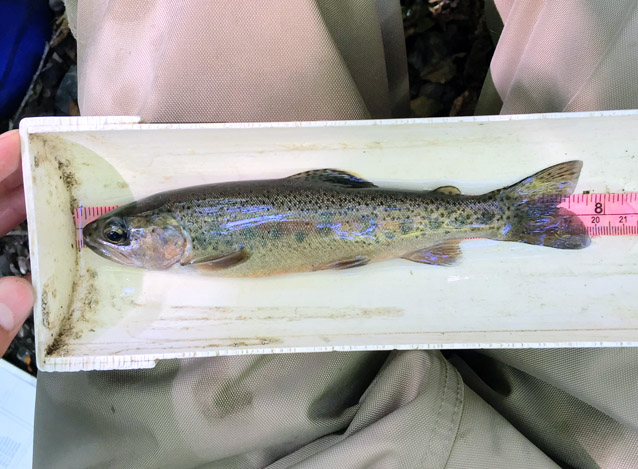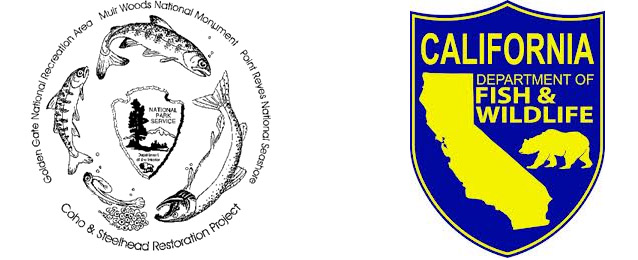Thank you to all of the volunteers who participated in the 2016 Summer Juvenile Salmonid Monitoring Surveys on Pine Gulch, Redwood, and Olema Creeks. Through your dedication and flexibility, all of this year’s juvenile coho and steelhead monitoring was completed successfully.
Monitoring Season Notes
Up Next!
The juvenile coho monitoring season has come to a close and the monitoring team is now gearing up for adult coho spawner surveys. Adult salmon have already migrated into Lagunitas Creek following recent storm events. Adult coho spawner surveys will begin soon with surveys following major storm events in late November through the middle of February. Spawner surveys conducted by the National Park Service will provide a census of adult coho spawning in West Marin.
Preliminary results from our juvenile coho basinwide surveys indicated a decrease in numbers on both Olema and Redwood Creeks when compared to the previous generation. The number of juvenile coho was fewer than anticipated given the strong return of spawning coho seen during the winter of 2015-2016. In particular, numbers were lower than expected in Olema Creek. Potential explanations include late winter storms that may have scoured coho redds and increased mortality of recently emerged fry, and increased spawning in tributary habitat that dried up during the summer. This is the seventh consecutive year that no coho juveniles were observed during summer surveys on Pine Gulch Creek.

Brentley McNeill / PRNSA
Olema Creek
A total of 2,658 juvenile coho were observed during summer basinwide surveys on Olema Creek, and another 474 were captured during electrofishing along fixed index reaches. When compared to the last time this generation was observed, the 2016 preliminary basinwide population estimate of 16,500 juveniles is lower than the 2013 estimate of 16,599, but within the 2013 95% confidence interval [13,075; 20,123]. Juvenile coho were observed throughout the 13 km stretch surveyed. A total of 247 coho juveniles were implanted with PIT (passive integrated transponder) tags to allow detailed tracking of individual fish throughout their lives. This allows us to capture data on growth between life stages, timing of migration, and survival.
Redwood Creek
A total of 604 juvenile coho were observed during the basinwide surveys on Redwood Creek, and an additional 127 juveniles were captured during index reach electrofishing. The 2016 preliminary population estimate of 2,500 juveniles is lower than the 2013 estimate of 3,159 95% CI [2,287; 4,031]. Although juvenile coho were seen throughout the mainstem of Redwood Creek, the highest concentration occurred between the confluence with Kent Creek and Bridge 1 in Muir Woods. Juvenile coho were not seen on the Fern Creek tributary this season. A total of 104 fish were PIT tagged during electrofishing surveys.
Due to the low number of juvenile coho remaining in Redwood Creek, the California Department of Fish and Wildlife called on a response team to collect juvenile coho and rear them to adulthood in a conservation hatchery located at Warm Springs Dam in Sonoma County. Staff from the National Park Service, Golden Gate National Parks Conservancy, Point Reyes National Seashore Association, California Department of Fish and Wildlife, and U.S. Army Corps of Engineers collected a total of 200 juvenile coho and transported them to the hatchery. Once they are reared to adulthood, they will be released back into Redwood Creek in the winter of 2018-2019 to spawn naturally.
Pine Gulch Creek
No coho juveniles were observed during basinwide or index reach surveys on Pine Gulch. This corresponds with the lack of coho spawning observed during the 2015-2016 winter.
Fish size summary
Based on preliminary calculations, the average fork length of coho juveniles captured on Olema Creek during the summer of 2016 was 65 mm, which is lower than the combined average of 71 mm from previous summers. The 2016 average fork length of coho juveniles on Redwood Creek was 74 mm, which is similar to the combined average from prior years of 73 mm.
Downstream migrant trapping will be performed during the spring of 2017 to evaluate the drought survival and overwintering success of juvenile coho salmon rearing in Olema and Redwood Creeks.
Steelhead trout summary
During 2016 summer monitoring, juvenile steelhead trout were also captured and measured. On Olema Creek the basinwide catch number of steelhead YOY (young of the year, or steelhead less than one year old) was lower than the last two years and lower than average. The number of steelhead 1+ (steelhead older than one year) was comparable to catch totals from previous years. On Redwood Creek, both the steelhead YOY and 1+ basinwide catch was the highest on record. The steelhead YOY basinwide catch for Pine Gulch Creek was comparable to previous year catch totals, while the 1+ steelhead catch total was the second lowest on record.
Average fork length for YOY steelhead on all three creeks was similar to the 2009-2015 combined average, though average fork length for 1+ steelhead on all three creeks was lower.
For More Information
Contact Michael Reichmuth at michael_reichmuth@nps.gov or call 415-464-5191.
The National Park Service shall not be held liable for improper or incorrect use of the data described and/or contained herein. These data and related graphics (if available) are not legal documents and are not intended to be used as such. The information contained in these data is dynamic and may change over time. The National Park Service gives no warranty, expressed or implied, as to the accuracy, reliability, or completeness of these data.

Last updated: November 16, 2016
